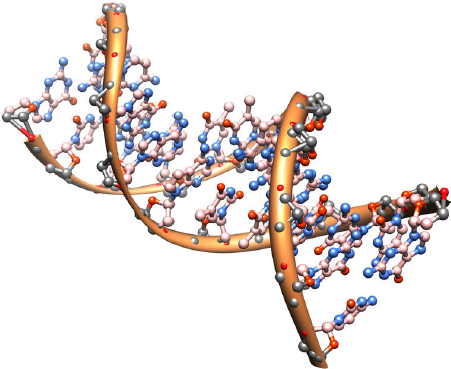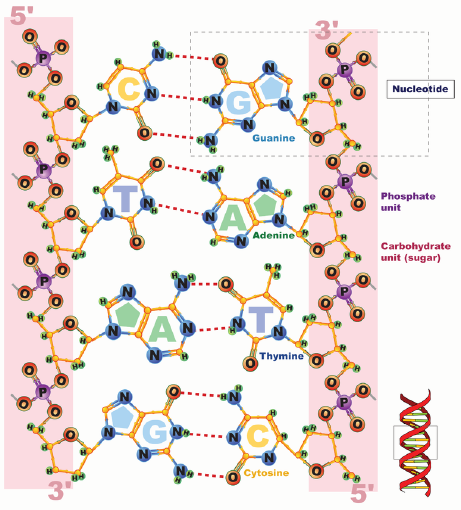Reading: DNA - The Genetic Material
Jessica Harwood
Douglas Wilkin, Ph.D.
http://www.ck12.org/saythanks
• Explain the importance of DNA.
• Define and describe a nucleotide.
• Describe the shape of DNA.
• Summarize the base-pairing rules.
Where’s the instructions?
How do your cells know what to do? Just like builders have blueprints to tell them how to build a house, your cells also have instructions. Your cells’ instructions are molecules of DNA.
What is DNA?
DNA is the material that makes up our chromosomes and stores our genetic information. When you build a house, you need a blueprint, a set of instructions that tells you how to build. The DNA is like the blueprint for living organisms. The genetic information is a set of instructions that tell your cells what to do.
DNA is an abbreviation for deoxyribonucleic acid. As you may recall, nucleic acids are a type of macromolecule that store information. The deoxyribo part of the name refers to the name of the sugar that is contained in DNA, deoxyribose. DNA may provide the instructions to make up all living things, but it is actually a very simple molecule. DNA is made of a very long chain of nucleotides. In fact, in you, the smallest DNA molecule has well over 20 million
nucleotides.
Nucleotides
Nucleotides are composed of three main parts:
1. a phosphate group.
2. a 5-carbon sugar (deoxyribose in DNA).
3. a nitrogen-containing base.
The only difference between each nucleotide is the identity of the base. There are only four possible bases that make up each DNA nucleotide: adenine (A), guanine (G), thymine (T), and cytosine (C).
The Genetic Code
The various sequences of the four nucleotide bases make up the genetic code of your cells. It may seem strange that there are only four letters in the “alphabet” of DNA. But since your chromosomes contain millions of nucleotides,there are many, many different combinations possible with those four letters.
But how do all these pieces fit together? James Watson and Francis Crick won the Nobel Prize in 1962 for piecing together the structure of DNA. Together with the work of Rosalind Franklin and Maurice Wilkins, they determined that DNA is made of two strands of nucleotides formed into a double helix, or a two-stranded spiral, with the sugar and phosphate groups on the outside, and the paired bases connecting the two strands on the inside of the helix (Figure 1.1).

FIGURE 1.1
DNA’s three-dimensional structure is a double helix. The hydrogen bonds between the bases at the center of the helix hold the helix together.
Base-Pairing
The bases in DNA do not pair randomly. When Erwin Chargaff looked closely at the bases in DNA, he noticed that the percentage of adenine (A) in the DNA always equaled the percentage of thymine (T), and the percentage of guanine (G) always equaled the percentage of cytosine (C). Watson and Crick’s model explained this result by suggesting that A always pairs with T, and G always pairs with C in the DNA helix. Therefore A and T, and G and C, are "complementary bases," or bases that always pair together, known as a base-pair. The base-pairing rules state that A will always bind to T, and G will always bind to C ( Figure 1.2). For example, if one DNA strand reads ATGCCAGT, the other strand will be made up of the complementary bases: TACGGTCA.

FIGURE 1.2
The chemical structure of DNA includes a chain of nucleotides consisting of a 5- carbon sugar, a phosphate group, and a nitrogen base. Notice how the sugar and phosphate form the backbone of DNA (strands highlighted in pink), with the hydrogen bonds between the bases joining the two strands.
Summary
• DNA stores the genetic information of the cell in the sequence of its 4 bases: adenine, thymine, guanine, and cytosine.
• DNA is made of a long chain of nucleotides consisting of a 5-carbon sugar, a phosphate group, and nitrogen-containing base.
Review
1. Describe the structure of DNA.
2. What does a nucleotide consist of?
3. What are the base-pairing rules?
4. If one DNA strand reads CCGTAATGCAT, what will be the sequence of the complimentary strand?
